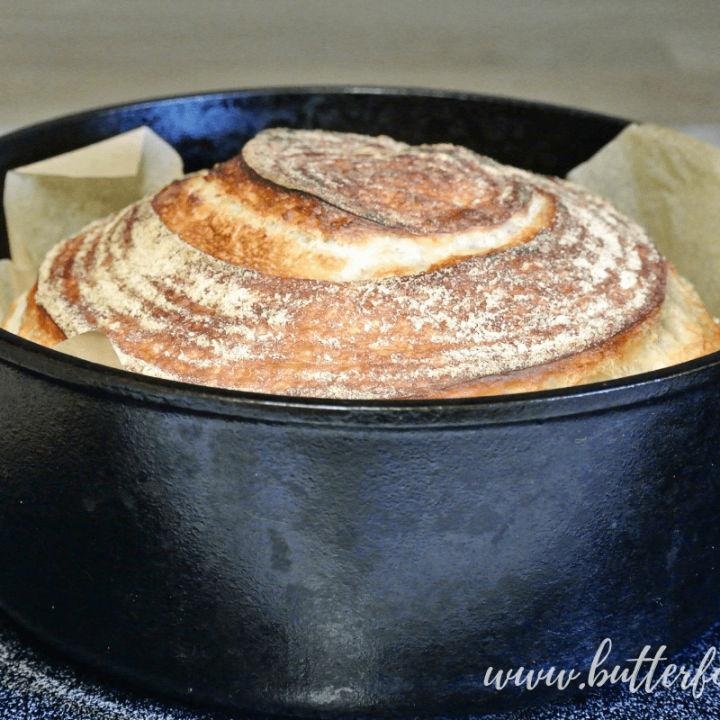How To Bake The Perfect Sourdough Boule In Your Dutch Oven
3.9
(55)
Your folders
Your folders
Cook Time: 40 minutes
Total: 40 minutes
Servings: 12
Author : Butter For All

Ingredients
Export 2 ingredients for grocery delivery
Instructions
Step 1
Weigh all ingredients into a glass or ceramic bowl.
Step 2
Mix the ingredients into a loose shaggy dough with a wooden spoon or dough whisk.
Step 3
Wet your hands and gently knead the dough in the bowl by hand until it comes together with no excess flour.
Step 4
Let the dough rest covered for 10-15 minuets.
Step 5
Start the first stretch and fold by wetting your hands and lifting one side of the dough and folding it toward the middle. Repeat this stretch and fold process in all four directions.
Step 6
Sometimes you can get away with an extra one or two folds depending on the elasticity of the dough. It it wants to stretch, stretch it! If it's tearing or breaking it needs a rest!
Step 7
Let the dough rest for 10 minutes.
Step 8
Start the second stretch and fold by wetting your hands and repeating the same folding motion in (at least) all four directions.
Step 9
Let the dough rest for 10 minutes.
Step 10
Repeat the stretch and fold and resting process up to 5 more times for a total of 7 stretch and folds (or as many as you are able). I have made great bread by just just doing two stretch and folds. But remember, the more stretching and folding, the more gluten will develop, and the higher your bread will rise!
Step 11
After the last stretch and fold cover the dough and allow it to double in size. This can take anywhere from 3-6 hours depending on starter strength and ambient temperature.
Step 12
Prepare your banneton (proofing basket) with a coating of flour. My trick is to use sprouted wheat flour. Sprouted wheat does not develop gluten so it will keep the bread from sticking to the basket. Rice flour, buckwheat or other non glutenous flour can also be used.
Step 13
Working with the doubled dough, start the final stretch and fold. This will act as the "punch down" of the dough, deflating the gasses trapped inside the gluten network. Stretch the dough several times toward the center, each time pressing down on the dough to remove air bubbles.
Step 14
Let the dough rest for 10 minutes.
Step 15
Lightly wet your hands and remove the dough from the proofing bowl onto your work surface. Shape the dough by repeating the same folding toward the center action. Once a tight ball is achieved flip it seam side down and push it gently in all directions across the work surface to build tension in the outer layer. (please see attached video)
Step 16
Let the dough rest seam side down for 5 minutes.
Step 17
Transfer the dough to the banneton basket. This time you want the seam to be up and the tight surface to be down in the basket.
Step 18
Sprinkle the seam side of the shaped dough with a light dusting of flour and cover it securely with wrap and a rubber band.
Step 19
Place the banneton basket in the refrigerator overnight for at least 10 hours. 12-24 hours is my preferred proofing time.
Step 20
Once the dough has crested the edge of the banneton it is ready to bake. But you may keep it in the refrigerator for a longer period of time.
Step 21
Preheat your oven to 450° with your covered Dutch oven inside!
Step 22
Cut a piece of parchment paper big enough to overhang your loaf's circumference by a few inches.
Step 23
Remove the banneton from the refrigerator, remove the wrap from the dough and place the parchment sheet over the exposed dough. Hold the parchment in place with your hand while you flip the dough onto the counter. Now the parchment is on the bottom.
Step 24
Carefully ease the banneton off the dough. Sometime it takes a little coaxing. Use your fingers to gently work between the dough and basket. Hopefully the basket will lift away clean!
Step 25
Using a sharp razor blade, score the dough along the top. There are so many scoring patterns to practice with, but a good one to start with is a simple slash or a cross. Score the dough about 1/2 inch deep.
Step 26
Using baking gloves remove the Dutch oven from the oven and remove the lid.
Step 27
Working quickly pick up the boule by the parchment paper edges and place it into the Dutch oven on top of the parchment.
Step 28
If desired add a few ice cubes to the Dutch oven between the parchment and the wall of the Dutch oven, or spray the boule with a few spritzes of filtered water. Adding additional moisture will keep the crust soft allowing for more rise and give a nice blistered texture and appearance.
Step 29
Cover the Dutch oven and place it back in your preheated oven. Bake undisturbed for 25 minutes!
Step 30
Open your oven and remove the Dutch oven lid. Bake an additional 15 minutes!
Step 31
Remove your Dutch oven from the oven and gently lift the boule out using the parchment paper as handles. Remove the parchment paper and cool the boule on a wire rack. Cool the boule completely before cutting (possibly the hardest part of baking this incredible loaf of bread!).